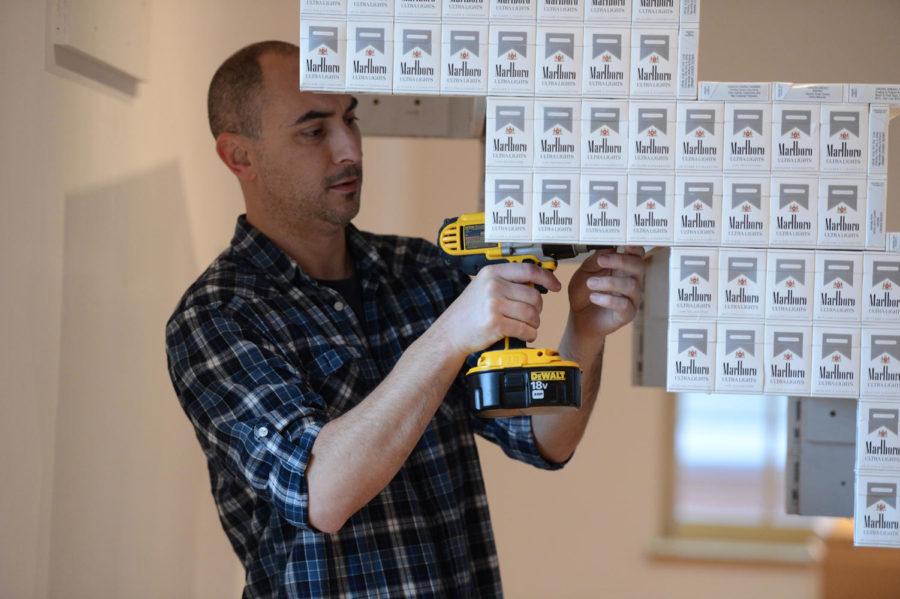Andrew Magee aims to engage audience through art
February 13, 2013
Cigarette cartons, sugar packets, toy soldiers and cans of fruit. What do all of these things have in common? They are materials used in artist Andrew Magee’s sculptures. His work will be on display in the Christian Petersen Art Museum in Morrill Hall until April.
“My first thought was how [Magee’s] art really has the ability to engage a student audience,” said Nancy Girard, educator of visual literacy and learning for the Iowa State Museums. “It is all approachable, understandable but it can also lead to a deeper level of thinking. This is the kind of visual appeal that works well to draw in students.”
Magee’s use of uncommon materials for his sculptures was acquired through his education. While pursuing his Bachelor of Fine Arts at Arkansas State University in Jonesboro, Arkansas and his Master of Fine Arts at Southern Illinois University in Carbondale, Illinois, he was taught to use commonplace items for his art. He would venture to places like junkyards, which allowed him to get a variety of materials for a cheap price, which in turn allowed him to create large pieces of artwork.
“I knew I wanted to be an artist as a college undergrad. When I started having success with my projects and was getting reactions, it encouraged me to elicit reactions from people through my artwork,” Magee said. “I get excited about others seeing my stuff.”
However, Magee said he understands his work is not for everyone. The pieces are often about controversial subjects like religion and politics.
“All I provide is the material, the image or sculpture and the title. The rest is completely up to the viewer to interpret,” Magee said.
Girard described the process of looking at Magee’s work as one in which the viewer has to step back to see the piece from a distance, get up close to see what it is made of then step back again to put them together and connect the meaning.
An example of this would be Magee’s “Stairway to Heaven.” “Stairway to Heaven” is a three-dimensional, 300-pound structure made of cigarette cartons that were personally smoked by Andy Magee himself.
“For someone who smokes, they would definitely get that this could be a stairway to death or the journey to quitting; but even people with no knowledge about smoking will still understand the message, to an extent,” Magee said. “I believe all of my pieces are used with materials that our culture and society are saturated with, like the cigarette cartons, for example.”
He explained that his pieces are intended to reveal an initial reaction, but also hold the viewer’s attention to find a deeper meaning and make a personal connection.
“Andy is very conversational, and he likes his art to be conversational as well,” Girard said. “He doesn’t want to tell you exactly what he was thinking. He wants you to think for yourself about what you’re looking at, and that’s a really important part of visual literacy.”
Having been an artist for a large part of his life, Magee also has a very strong opinion on art in relation to society in today’s day and age. He said he believes artists are supposed to create work to challenge and accost society. He said that he feels that artists have allowed themselves to fall out of the public’s interest.
“The term art is now too broad. Years ago, if you were to ask any random person on the street who their favorite artist was, they would say someone like Michelangelo, Leonardo DaVinci or Pablo Picasso,” Magee said. “Now, if you were to ask anyone on the street who their favorite artist is, someone like Beyonce would be their answer.”
Magee said he believes artists and their artwork can reveal truths and shape ideas if people engage with it, hence the reason he strives for art that is engaging to the audience.
“It’s unconventional and challenging,” Magee said about his work. “Money may not be a part of the life, and you may work 24 hours a day. If, after all of that, you are still passionate, then it’s what you’re meant to do. Life is a journey; you have to pursue what you love.”







